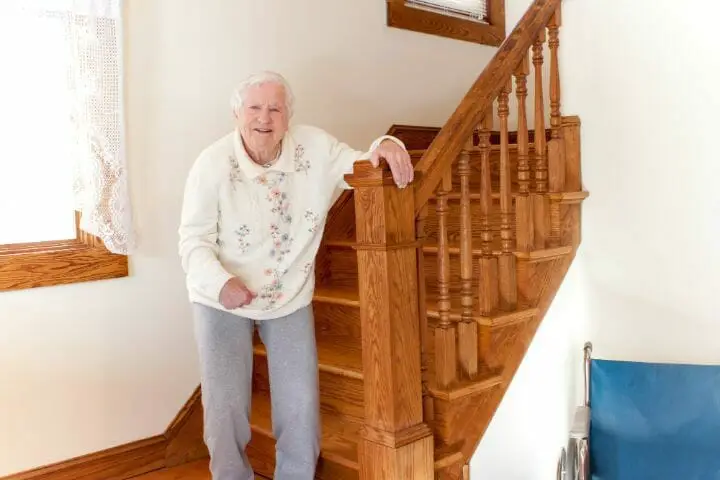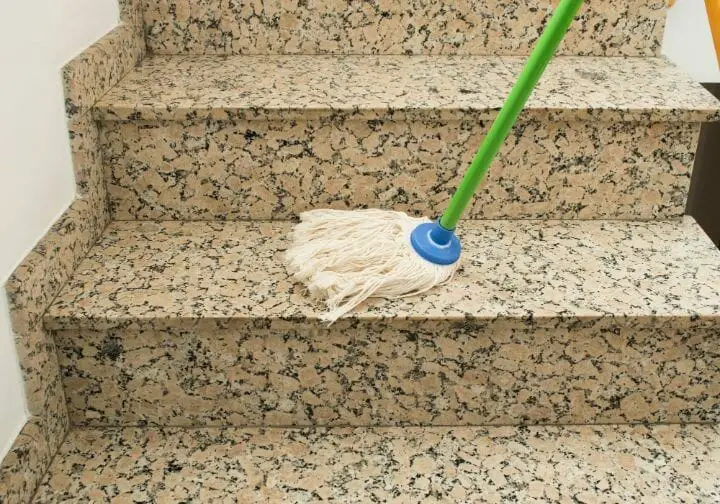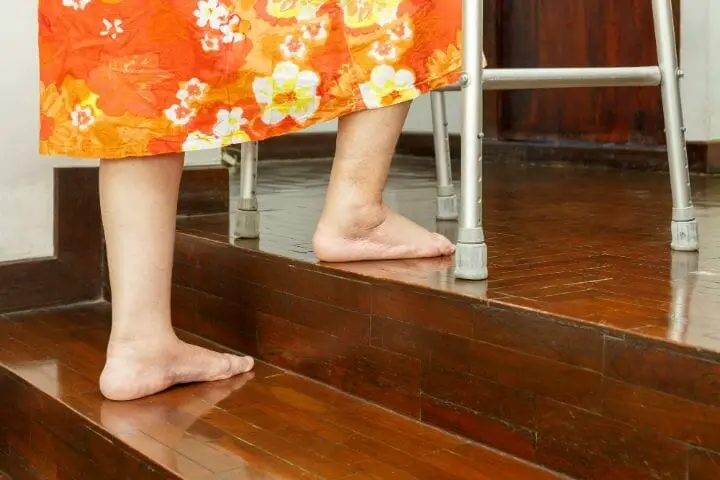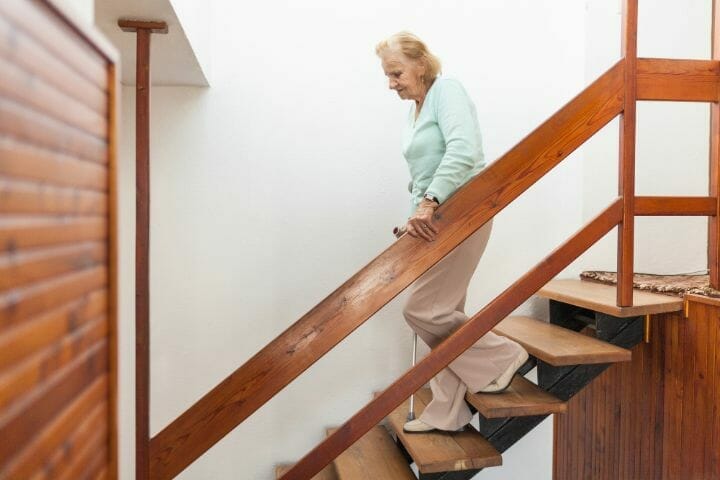Whether it is at a workplace or at home, stairs are integral parts of many of our lives, particularly in suburban homes. It is extremely critical for us to provision for safety on staircases and prevent slips, trips, and falls on the stairs.
This provisioning becomes even more important if the potential users of these stairs are seniors because any injury in old age can be life-threatening.
Through this article, let’s have a detailed look at various aspects of making the staircase safer for our seniors.
Contents
Using Stairs – Good or Bad or Good but Risky?
Have you ever fallen down the staircase? I hope not, because believe me it is not a very good feeling. I remember rolling down the stairs when I was just 5 years old. Lucky me, I came out without any major injury.
It may be because like any other 5 years old, I was short and flexible, and the width of the stairs was more than my height. In 4-5 seconds, I was on the first stair from the 35th stair without hitting my head on any of the sidewalls of the stairway.
During pandemic times, when we are tracking the number of Covid-19 infections, it is no less alarming to know that more than 1 million accidental injuries occur each year as the result of stairway falls, which is the major cause of accidental injury.
Every year,12,000 deaths are seen because of stairway accidents. According to another research performed to evaluate the risk associated with using staircases, most of the injuries occurred among young children and seniors [2]. Moreover, one more research demonstrated that more than 80% of deaths in Stairway accident cases were from a head injury [3].
While these statistics may seem humbling, using stairs is not all that bad. Stairs can be the best fitness tools that one can have without spending any extra buck. A 20 min up and down on the staircase in a day can increase one’s endurance substantially.
To prove the point, few scientists, as part of a clinical study, conducted a controlled experiment for over 8 weeks period and published in the British Journal of Sports Medicine.
This study observed that for a control group, a 90- min stair climbing increased the VO2 max (maximum rate of oxygen consumption) by 17.1% and reduced the low-density lipoprotein (LDL) cholesterol by 7.7% [4].
So, it is quite evident that climbing up and down stairs can be a great physical exercise one can get. However, like any other fitness regime or tool, using staircases comes with its own risk of falling and hurting yourself.
Therefore, individuals who have constructed the stairway or have the responsibility of maintaining it must ensure that all safety measures have been put in place before allowing unsuspecting individuals to use the stairway – whether it is for fitness, utility at home, public mobility, or occupational use at work.
You may also like Are Hot Tubs Safe for Elderly People?
Making Stairs Safe
When it comes to a workplace setting, the Canadian Centre for Occupational Health and Safety (CCOHS) [5], has provided guidelines to prevent slips, trips, and falls on stairs. The same concepts can also be adopted in private homes or public spaces.
When constructing or opening a stairway for human use, one must keep various aspects such as stair dimensions, stair surface, stair handrails, and visibility on stairs in mind.
Once a stairway is constructed, all the users must be made aware of how to use that stairway safely. Let’s have a look at a few of these aspects in little more detail.
Stair Dimensions:
Although Stair dimensions may change depending on the purpose of their usage, we must keep all the steps of the same size and height. Also, it is important to ensure they are safely accessible. For Ex. If doors open directly into the stairway, one should provide a wide platform, min of 50 cm, beyond the door-swing.
Moreover, the maximum number of steps between landings is recommended to be 18, with 1 or 2 flights in the same direction. Having more than 2 flights in the same direction may give a few of the individuals climacophobia – a fear of climbing stairs.
You may also like How to Keep Seniors Safe on the Internet
Surface Texture and Covering:
While it is very intuitive that the surface shall not be very slippery, stairs must also be maintained properly. In addition to that, we must repair any uneven surfaces, cracks, or protruding nails that may have come out because of heavy use of the stairway.
Also, loose coverings on the stairs are a major cause of stairway accidents. Therefore, steps must be covered by the material made of well-secured rubber or non-slippery rugs.
Handrails:
Handrails play one of the most important roles in making the staircases safe for use. While having well-secured handrails on both sides of the stairs is ideal, a handrail on at least one side is non-negotiable from a safety point of view.
Also, handrails must be of appropriate dimension so that individuals can grasp it easily by full hand around it. The handrail surface should be made smooth without making it slippery. So that stairway users can run their hands smoothly along the entire length without having to adjust their grip.
While keeping the handrail height around 3 feet or less than 1 meter will make it comfortable for use by adults, we must keep the necessary clearances in the handrail guards to mitigate the risk of children falling through them.
You may also like Can I Use a Baby Monitor as a Security Camera?
Visibility:
We must install lights and switches at the bottom and at the top of the stairway to keep them well-lit. Also, make sure the steps’ edges are visible without any obstruction.
It can be accomplished by painting a contrasting color on the edge of the steps. To make temporary alterations though, it can also be done by applying special strips.
User Awareness and Housekeeping:
Even after having best-designed stairways for the specific need, the risk of individuals’ falling or hurting themselves doesn’t go away. Therefore, stairways must be maintained properly and used safely.
The individuals or team responsible should specifically focus on two aspects – one is that they must ensure any liquid spilled on stairs is wiped out at the earliest once it is known, and second, they must keep stairs free of any clutter.
User awareness is also critical to mitigating the risk of staircase-related injuries. We should see that users, whether in a professional work setting or home setting, take proper cautions when using staircases.
They must climb stairs up or down slowly with a hand on the handrail, and not rush. They should use the right glasses or remove if required, to have full visibility of stairs.
You may also like Best Medical Alert System with Fall Detection
Custom Changes in Staircases for Most Vulnerable Demography – Seniors and Children
It may not be very difficult to make the staircase safe if you know intended users who will be using those stairways and their usage patterns. However, what should one do, when the user profile or usages patterns change drastically. In case you think, it is very rare to see any change in the user profile of usage patterns, you may want to think again.
When a young couple builds a house, stairs may only require the basic safety features described above. However, after a few years, their family expands, and then would have young souls using the staircase – it is a change in the user profile. Similarly, if after a few years, their parents start living with them, once again user profile would change.
With every change in the users’ profile or intended use, stairways may have to be customized to ensure they are as safe for new users as for the ones those were originally designed for. Therefore, we must be able to make reversible custom changes to cater to our temporary or permanent needs.
Custom Changes for Children
If the original stairs are of very hard surface, Non-Slip Carpet Stair Treads (amazon), may be of great help to make the stairs safer for kids when they are crawling. Similarly, reducing the clearance from handrail guards (amazon) will ensure small kids don’t get slip through them.
Custom Changes for Seniors
Resting space – Seniors, when climbing the stairs may get tired midway. To help them cover the distance, it is a good idea to add a resting space mid-way. It can be a small foldable sitting pad attached to the sidewall if seniors can’t sit down on the stair floor itself.
Stairlifts – Sometimes, an individual may have a mobility issue that limits his or her ability to get up and down. In these cases, stairlifts attached to a handrail on the side of the wall will be great mobility assistance.
Stair walker – it can be a great way to make climbing down even more secure. Attached to the handrail, it is particularly helpful when an individual can’t have a firm grip on the handrails.
There are many other custom attachments one can use to increase the safety of using staircases and mitigate risks of injury. So, next time you have a new person in your home who has a Staircase, you must think of making it more accessible for him or her.





